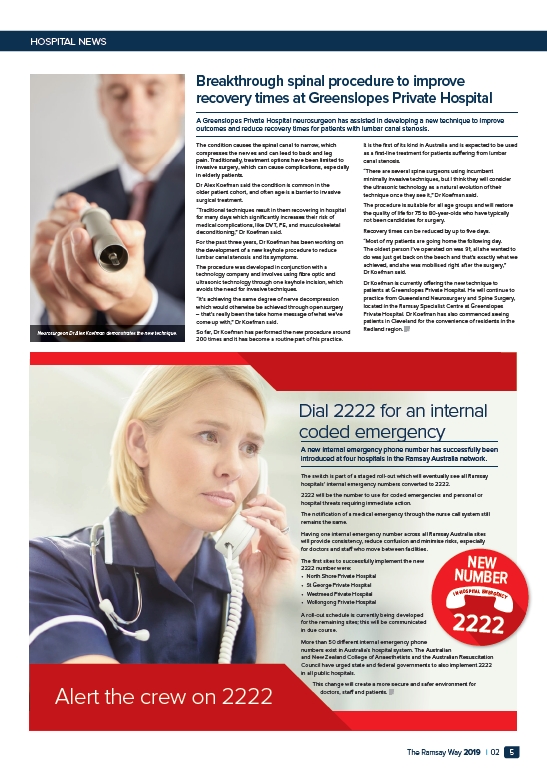
Breakthrough spinal procedure to improve
recovery times at Greenslopes Private Hospital
A Greenslopes Private Hospital neurosurgeon has assisted in developing a new technique to improve
outcomes and reduce recovery times for patients with lumbar canal stenosis.
Dial 2222 for an internal
coded emergency
A new internal emergency phone number has successfully been
introduced at four hospitals in the Ramsay Australia network.
The switch is part of a staged roll-out which will eventually see all Ramsay
hospitals’ internal emergency numbers converted to 2222.
2222 will be the number to use for coded emergencies and personal or
hospital threats requiring immediate action.
The notification of a medical emergency through the nurse call system still
remains the same.
Having one internal emergency number across all Ramsay Australia sites
will provide consistency, reduce confusion and minimise risks, especially
for doctors and staff who move between facilities.
The first sites to successfully implement the new
2222 number were:
• North Shore Private Hospital
• St George Private Hospital
• Westmead Private Hospital
• Wollongong Private Hospital
A roll-out schedule is currently being developed
for the remaining sites; this will be communicated
in due course.
More than 50 different internal emergency phone
numbers exist in Australia’s hospital system. The Australian
and New Zealand College of Anaesthetists and the Australian Resuscitation
Council have urged state and federal governments to also implement 2222
in all public hospitals.
This change will create a more secure and safer environment for
doctors, staff and patients. Alert the crew on 2222
The Ramsay Way 2019 | 02 5
HOSPITAL NEWS
NEW
NUMBER
I N-H OS PITAL EMER G E NCY
2222
The condition causes the spinal canal to narrow, which
compresses the nerves and can lead to back and leg
pain. Traditionally, treatment options have been limited to
invasive surgery, which can cause complications, especially
in elderly patients.
Dr Alex Koefman said the condition is common in the
older patient cohort, and often age is a barrier to invasive
surgical treatment.
“Traditional techniques result in them recovering in hospital
for many days which significantly increases their risk of
medical complications, like DVT, PE, and musculoskeletal
deconditioning,” Dr Koefman said.
For the past three years, Dr Koefman has been working on
the development of a new keyhole procedure to reduce
lumbar canal stenosis and its symptoms.
The procedure was developed in conjunction with a
technology company and involves using fibre optic and
ultrasonic technology through one keyhole incision, which
avoids the need for invasive techniques.
“It’s achieving the same degree of nerve decompression
which would otherwise be achieved through open surgery
– that’s really been the take home message of what we’ve
come up with,” Dr Koefman said.
So far, Dr Koefman has performed the new procedure around
200 times and it has become a routine part of his practice.
It is the first of its kind in Australia and is expected to be used
as a first-line treatment for patients suffering from lumbar
canal stenosis.
“There are several spine surgeons using incumbent
minimally invasive techniques, but I think they will consider
the ultrasonic technology as a natural evolution of their
technique once they see it,” Dr Koefman said.
The procedure is suitable for all age groups and will restore
the quality of life for 75 to 80-year-olds who have typically
not been candidates for surgery.
Recovery times can be reduced by up to five days.
“Most of my patients are going home the following day.
The oldest person I’ve operated on was 91; all she wanted to
do was just get back on the beach and that’s exactly what we
achieved, and she was mobilised right after the surgery,”
Dr Koefman said.
Dr Koefman is currently offering the new technique to
patients at Greenslopes Private Hospital. He will continue to
practice from Queensland Neurosurgery and Spine Surgery,
located in the Ramsay Specialist Centre at Greenslopes
Private Hospital. Dr Koefman has also commenced seeing
patients in Cleveland for the convenience of residents in the
Redland region.
Neurosurgeon Dr Alex Koefman demonstrates the new technique.